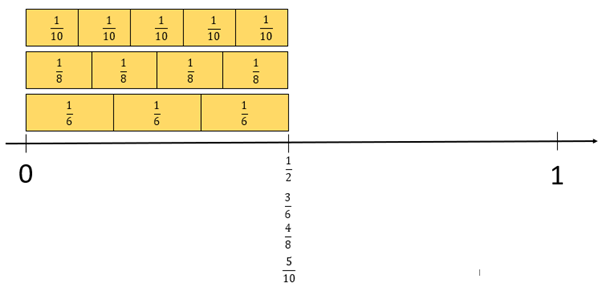Purpose
The purpose of this activity is to support students understanding that an infinite number of fractions (equivalent fractions) can represent the same quantity.
Achievement Objectives
NA3-1: Use a range of additive and simple multiplicative strategies with whole numbers, fractions, decimals, and percentages.
NA3-5: Know fractions and percentages in everyday use.
Required Resource Materials
- Strips of paper and Fraction Strips
Activity
- Use fraction strips to explore making different fractions that equal one half. Students might already know some simple examples, such as 2/4 and 4/8.
Record the equivalent fractions as equalities like 1/2 = 2/4 and 1/2 = 5/10.
Reinforce the idea that these fractions represent the same quantity.
Look for students to notice that numerators and denominators are multiplies or divided by the same factor.
- Explore folding strips of paper to create equivalent fractions and support students to image the fractions that are created. Good examples are:
- Fold a strip into halves and shade one half. Fold the strip back into halves and fold the halves into three equal parts (thirds). What are the smaller equal parts called? (sixths) How many sixths are shaded? (3/6) How can we record the equivalence? (1/2 = 3/6)
- Fold a strip into thirds. Shade two thirds. Fold the strip back into thirds and fold the thirds into quarters. What are the smaller equal parts called? (twelfths) How many twelfths are shaded? (8/12) How can we record the equivalence? (2/3 = 8/12)
- Fold a strip into fifths. Shade three thirds. Fold the strip back into fifths and fold the fifths into thirds. What are the smaller equal parts called? (fifteenths) How many fifteenths are shaded? (9/15) How can we record the equivalence? (3/5 = 9/15).
- Draw attention to the meaning of the multiplication of the numerator and denominator by a common factor.
For example, presents students with the expression 3/5 = 9/15.
Why did you end up with nine equal parts? (Three parts were folded into three parts each. 3 x 3 = 9).
Why did you end up with fifteenths? (Fifths are five equal parts that make one. If each fifth is folded into three equal parts there are 15 equal parts, since 3 x 5 = 15).
- Provide equations where students need to find the missing numerator or denominator. Work only on examples where the numerator and denominator of the left side fraction are multiplied. Ask students to complete the equation and create a physical or diagrammatic model to the equivalence.
Examples could include:
- 2/3 = [ ]/12

- 4/5 = 12/[ ]

- 3/8 = [ ]/16

- 5/4 = 10/[ ]

- 2/3 = [ ]/12
Next steps
- Increase the level of abstraction by progressing from using fraction strips to diagrams, and then symbols only.
- Ask students to rename improper fractions and mixed numbers as equivalent fractions. For example, 24/5 = 48/10.
- Explore equivalence where a fraction is renamed by dividing the numerator and denominator by a common factor, e.g. 3/[ ] = 9/12. Ask students to create diagrams to explain and justify the renaming.
Add to plan
Level Three